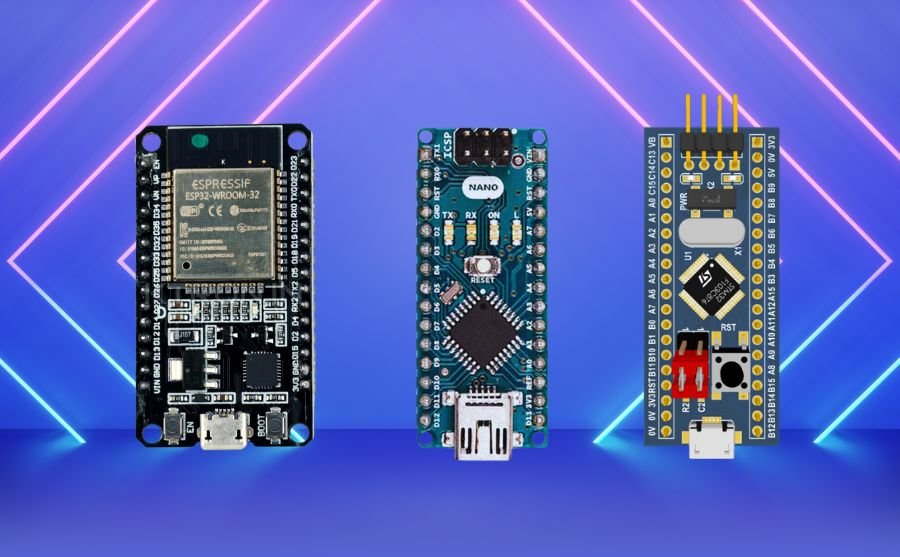ESP32 vs Arduino vs STM32: Which Microcontroller is Suitable for Your Project?

Microcontrollers are at the heart of countless embedded systems, from smart home devices to industrial automation. Among the most popular choices are the ESP32, Arduino, and STM32. Each of these microcontrollers has distinct features, advantages, and limitations. Understanding their differences will help you select the best option for your project.
1. ESP32
The ESP32, developed by Espressif Systems, is a feature-rich microcontroller with built-in Wi-Fi and Bluetooth connectivity.
Pros:
- Wi-Fi and Bluetooth Connectivity: Ideal for IoT projects and wireless communication.
- Dual-Core Processor: Capable of handling complex tasks and multitasking.
- High Performance: Clock speeds up to 240 MHz.
- Extensive GPIOs: Supports various peripherals like I2C, SPI, ADC, and PWM.
- Low Power Consumption: Includes power-saving modes for battery-operated devices.
- Affordable: Great value for its features.
- Large Community Support: Plenty of tutorials, forums, and libraries.
Cons:
- Limited ADC Accuracy: Analog readings may not be as precise compared to other microcontrollers.
- Complexity: More challenging to configure for beginners.
- Limited Real-Time Control: Not ideal for applications requiring strict timing.
Best For:
IoT applications, smart home devices, wireless data logging, and projects requiring internet connectivity.
2. Arduino
The Arduino platform, based on Atmel’s AVR microcontrollers (like ATmega328P), is renowned for its simplicity and beginner-friendliness.
Pros:
- Ease of Use: Designed for beginners with a straightforward programming environment.
- Large Ecosystem: Thousands of shields, libraries, and tutorials available.
- Low Cost: Affordable hardware for prototyping.
- Wide Variety of Boards: Options range from basic (Uno, Nano) to more advanced (Mega, Due).
- Community Support: Massive global user base.
Cons:
- Limited Processing Power: Typically runs at 16 MHz, which may not suffice for demanding applications.
- No Built-in Connectivity: Basic models lack Wi-Fi or Bluetooth (add-ons required).
- Limited Peripherals: Fewer features compared to ESP32 or STM32.
- Less Power Efficient: Higher power consumption compared to modern microcontrollers.
Best For:
Prototyping, educational projects, simple robotics, and basic sensor data logging.
3. STM32
The STM32 series, from STMicroelectronics, is a high-performance family of ARM Cortex-based microcontrollers.
Pros:
- High Processing Power: Clock speeds up to 480 MHz in advanced models.
- Wide Range of Features: Includes ADCs, DACs, timers, and communication protocols.
- Scalability: Offers a variety of models to suit different performance and cost needs.
- Real-Time Performance: Equipped with advanced timers and features suitable for time-critical applications.
- Low Power Options: Specialized lines (e.g., STM32L) for battery-powered devices.
- Rich Development Ecosystem: Includes STM32CubeMX, HAL libraries, and advanced debugging tools.
Cons:
- Steeper Learning Curve: Requires familiarity with ARM architecture and peripheral configuration.
- Higher Cost: Advanced models can be expensive.
- Limited Community Resources: Smaller community compared to Arduino.
Best For:
Industrial automation, real-time applications, advanced robotics, and projects requiring high performance or low power consumption.
Comparison Table
| Feature | ESP32 | Arduino | STM32 |
|---|---|---|---|
| Processor | Dual-core (up to 240 MHz) | AVR (8-bit, 16 MHz) | ARM Cortex (32-bit, up to 480 MHz) |
| Connectivity | Wi-Fi, Bluetooth (built-in) | None (basic models) | Add-ons required |
| Ease of Use | Moderate | High | Moderate to Advanced |
| Power Consumption | Low | High | Varies (low-power options available) |
| Cost | Affordable | Low | Moderate to High |
| Applications | IoT, smart devices | Education, prototyping | Industrial, real-time systems |
Which Microcontroller is Suitable for Your Project?
- Choose ESP32 if:
- Your project involves IoT or wireless communication.
- You need a cost-effective and feature-rich microcontroller.
- Moderate programming experience is available.
- Choose Arduino if:
- You are a beginner or teaching microcontroller programming.
- Your project does not require high performance or connectivity.
- Quick prototyping is a priority.
- Choose STM32 if:
- You need high processing power or advanced features.
- The project involves real-time control or industrial-grade performance.
- You have experience with ARM-based microcontrollers.
Conclusion
The choice between ESP32, Arduino, and STM32 depends on your project’s complexity, performance requirements, and your familiarity with the platform. For IoT and wireless communication, the ESP32 is a clear winner. For simplicity and quick prototyping, Arduino is unmatched. When performance, scalability, and real-time capabilities are crucial, STM32 is the go-to option.
Carefully evaluate your project needs to select the best microcontroller that ensures efficiency, cost-effectiveness, and ease of implementation.